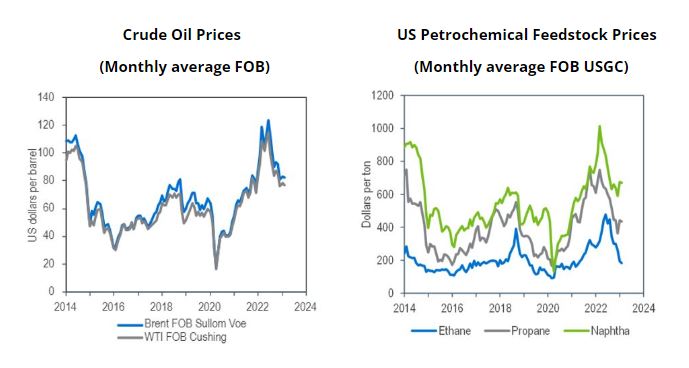Crude oil and refining: Quarter one performance

Optimism for brisk upturn in oil demand as business in China re-opening shielded oil prices from steep decline in global gas prices as sufficient inventories were demonstrated through the winter.
The position of global oil markets was opaque opening in 2023 as re-opening of business in China against deterioration of the broader economic climate exerted contrasting demand side pressures. Global crude oil supply steadied, with a lower price point and lower OPEC+ production quotas implemented in November capping production. Brent crude oil prices stabilised at around an average of US$82.5 per barrel through January and February, having surrendered the supply side risk premium built a year earlier. The cost of petrochemical feedstocks sourced from refineries rebounded as demand in China firmed. Cost advantage of feedstocks derived from gas widened as sufficient inventories of gas were demonstrated through the winter.
Crude oil and refining: Quarter one performance
Suspension of zero COVID-19 policy in China revived world oil demand growth at the start of 2023, countering slowing growth in a deteriorating global economic climate.
A deteriorating economic climate slowed annual growth in world oil demand towards one percent in quarter four. The rapid pace of interest rate hikes to manage stubbornly high inflation rates left Western markets most vulnerable and financial stability of some banks was stressed. Oil demand in Western Europe slumped six percent on the year in December, marking the fourth consecutive month of slowing demand. Naphtha and diesel bore most of the 0.4 mmbpd drop in demand. Oil demand in the United States plunged 5.5 percent on the year as harsh winter storms curtailed transportation fuel demand in December against increasingly fragile industrial demand. The rejection of the zero-COVID-19 policy in China moved upside into Asian demand opening 2023. Oil demand growth in China rallied to 5.5 percent on the year in January. Naphtha and kerosene contributed 55 percent of the 0.85 mmbpd growth in total oil demand, with aviation and petrochemical industries reacting swiftly to lifting of restrictions.
Wider restrictions on sales of Russian crude oil and products had little impact on supply. Lower price point in lengthening oil markets encouraged OPEC + to considered deeper production cuts.
Steady world crude oil supply was aligned with demand side inertia as a lower crude oil price point capped production. Estimated global oil production of 101.6 mmbpd in January and February was up 2.5 percent on the year but closely matched volumes in quarter four. The implementation of a price cap on Russian crude oil exports by the G7 and a ban on oil product imports into the European Union had little impact on supply from Russia as cargoes were redirected to India and China. Steady OPEC production following implementation of a 2 mmbpd cut to OPEC+ production quotas in November remains close to volumes a year ago, retaining a 28.3 percent share of global supply.
Steep upturn in crude oil prices on supply side risk as conflict in Ukraine emerged a year ago was cleared by start of 2023 and prices stagnated with markets seeking direction.
Great uncertainty in the outlook for demand left prices range bound with Brent prices confined between US$80 and US$85 per barrel through January and February. News of firming demand in China and potential tightening of OPEC+ production promoted upside to prices as contrasting news of faltering demand or growing inventory stalled prices. An emerging consensus view of weakening oil markets prompted a renewed downturn in prices moving into March and Brent prices retreated towards the US$75 per barrel point averaged through 2021.
Cost of petrochemical feedstocks sourced from refineries rebounded briskly as reopening of business in China and tightening restrictions on Russian exports prompted fears of shortages.
The downturn in crude oil prices was not immediately apparent in petrochemical feedstock costs sourced from the refinery as petrochemical demand rebounded briskly on reopening of business in China. Naphtha prices strengthened to a seven month high above US$700 per ton in February restoring more typical crack spreads against easing crude oil prices. Refinery profitability eased as crack spreads for most fuels narrowed against growing stocks. Cost advantage of feedstocks derived from gas widened as a critical pinch in global gas markets abated. Ethane prices in the United States tumbled 35 percent from quarter four to realign with the average achieved over the last decade.
Find out more...
Quarterly Business Analysis: Global - Petrochemicals, Polymers and C1 Chemicals - Q1 2023
The Quarterly Business Analysis provides key insight into production economics for a broad range of commodity petrochemicals, polymers and C1 chemicals. The analysis presents a review of costs, prices and margins for typical production assets, providing a valuable view of regional and value chain competitiveness and is is available for each key price setting region - Asia Pacific, Middle East, Western Europe and the United States. A quarterly report provides insightful commentary to illustrate current trends, related to recent market developments. The accompanying database is updated monthly.
UPCOMING WEBINAR...
In this 45 minute webinar, NexantECA will present its views on the industry performance during the first quarter of 2023, as well as summarise how petrochemical production economics have reacted, sourcing material from the Quarterly Business Analysis reports.
Wednesday, April 19, 2023 @ 9AM BST
Duration: 45 minutes
Wednesday, April 19, 2023 @ 2PM BST
Duration: 45 minutes
About the Presenter...
Andrew Powell, Project Manager
Andrew has 20 years of experience analysing petrochemical industry performance with NexantECA. He is an expert in assessing production economics and preparing price forecasts spanning the full petrochemical industry value chain, from refinery to specialty chemicals. Andrew leads development of NexantECA Subscriptions analysis of profitability and pricing across the global petrochemical industry.
Andrew Powell

